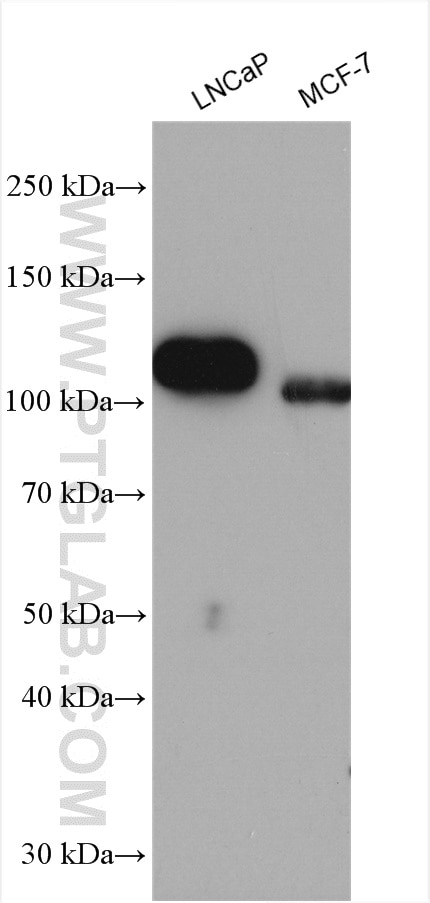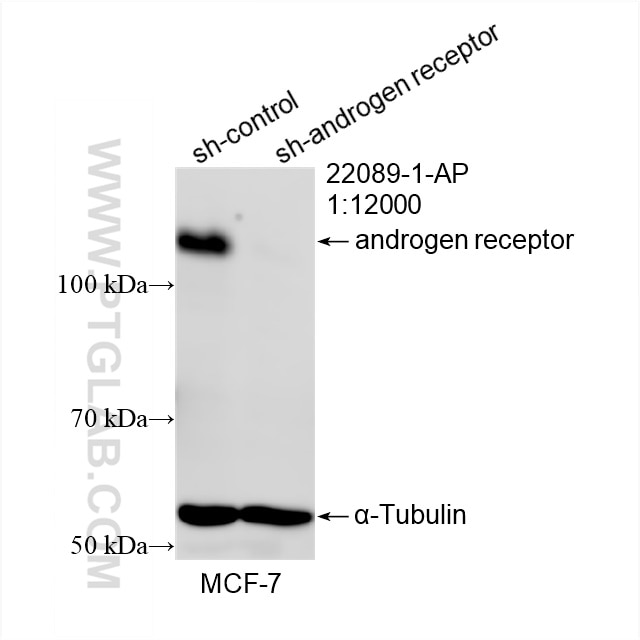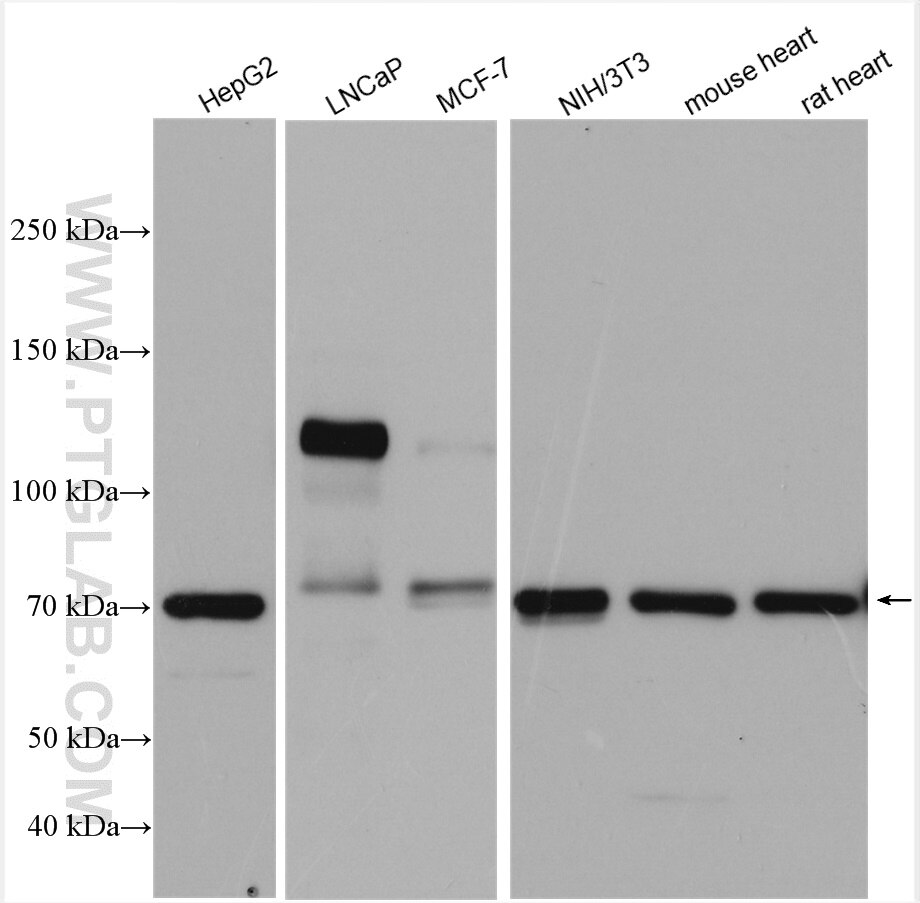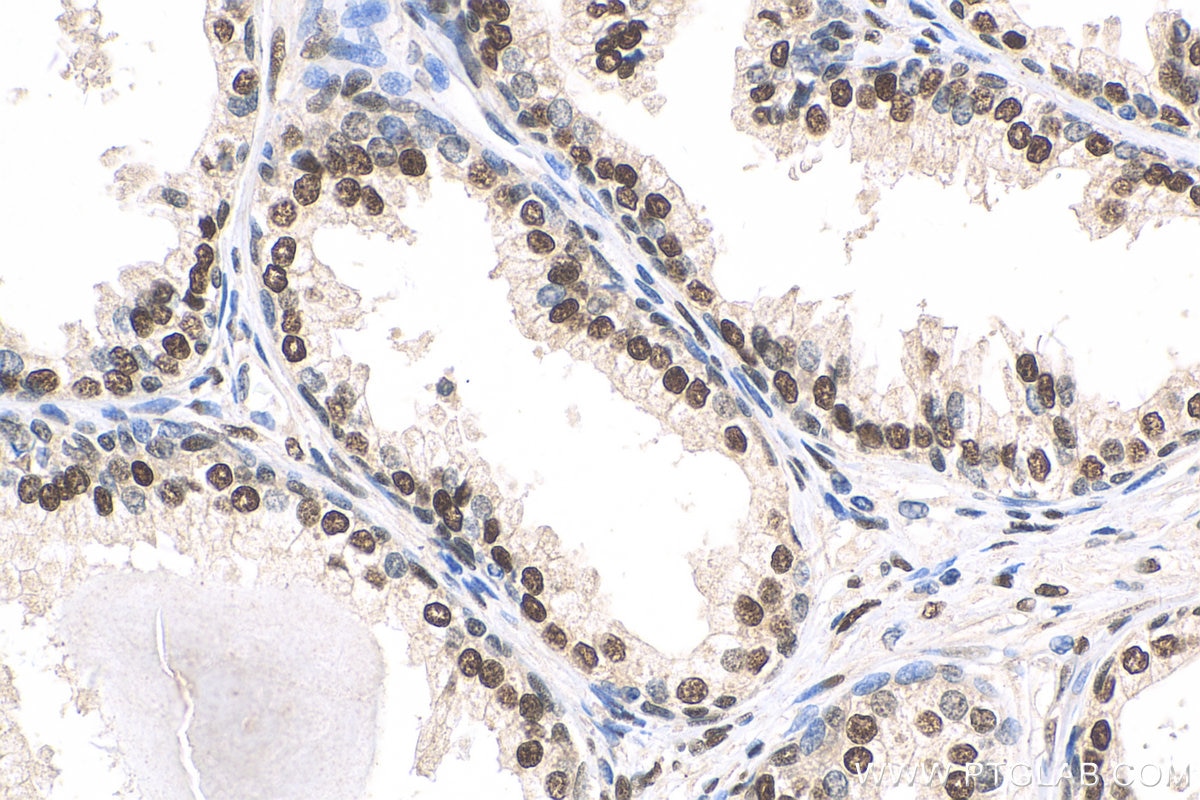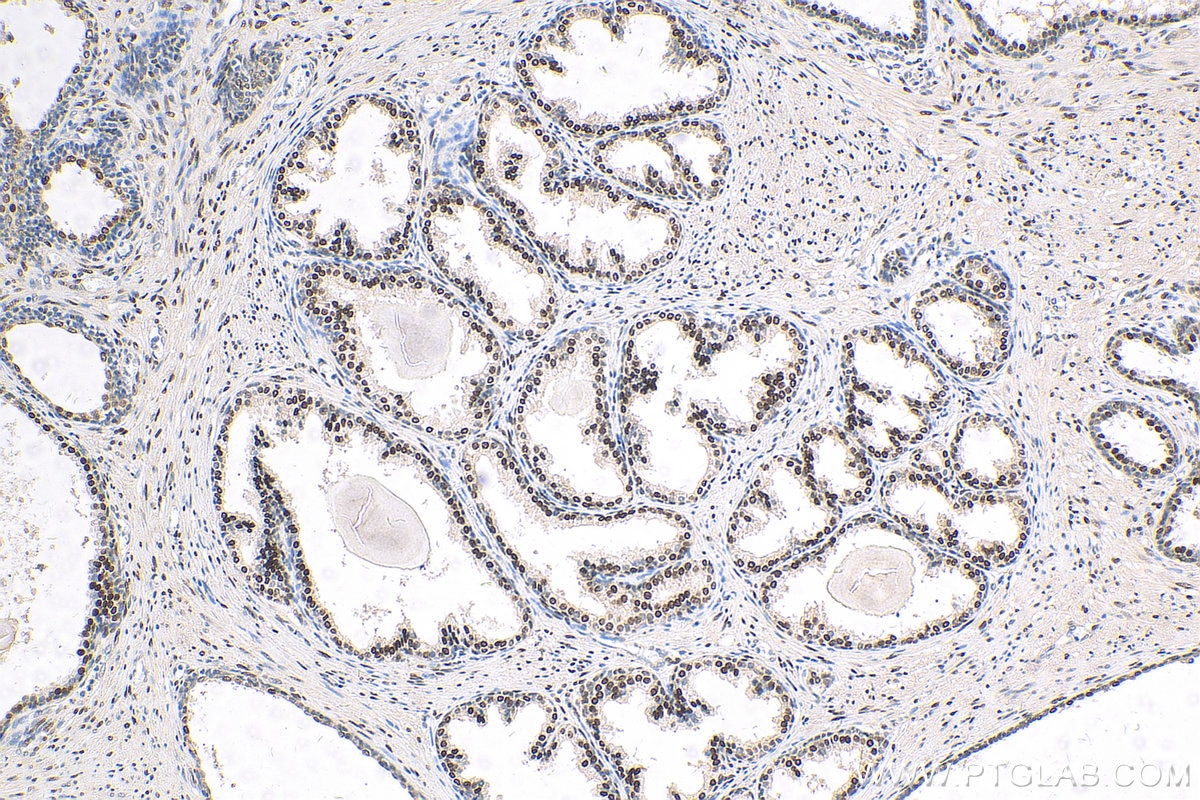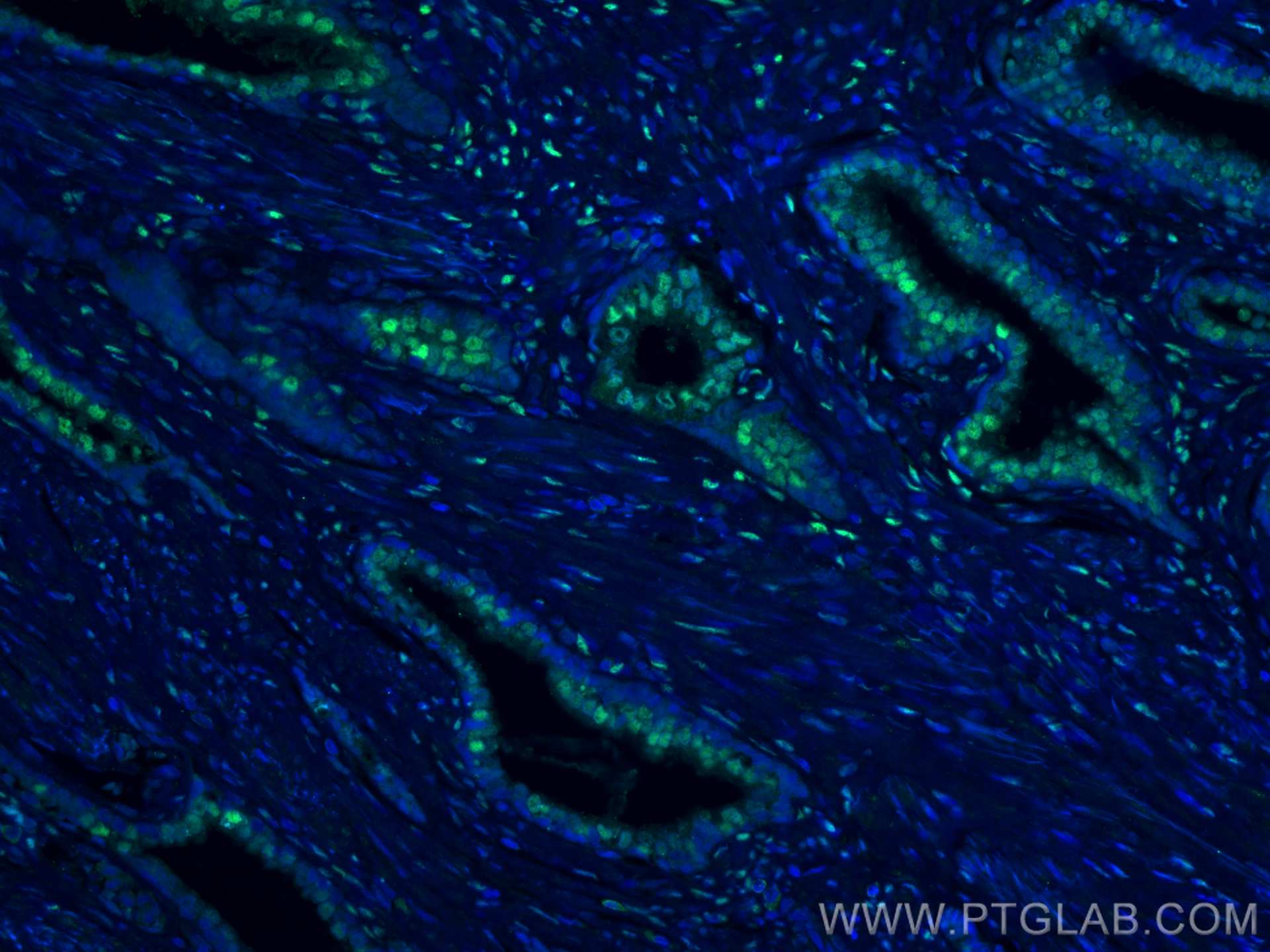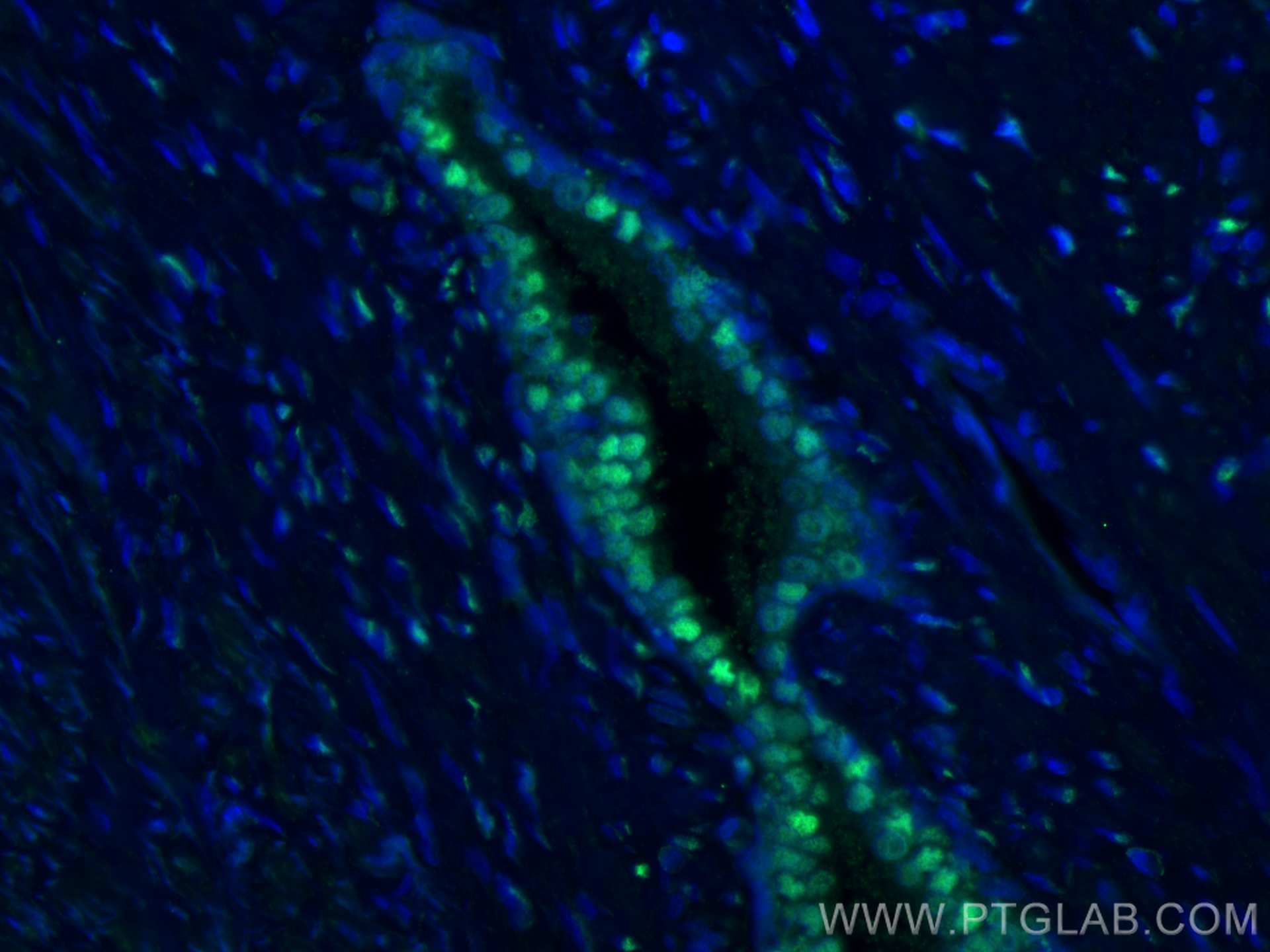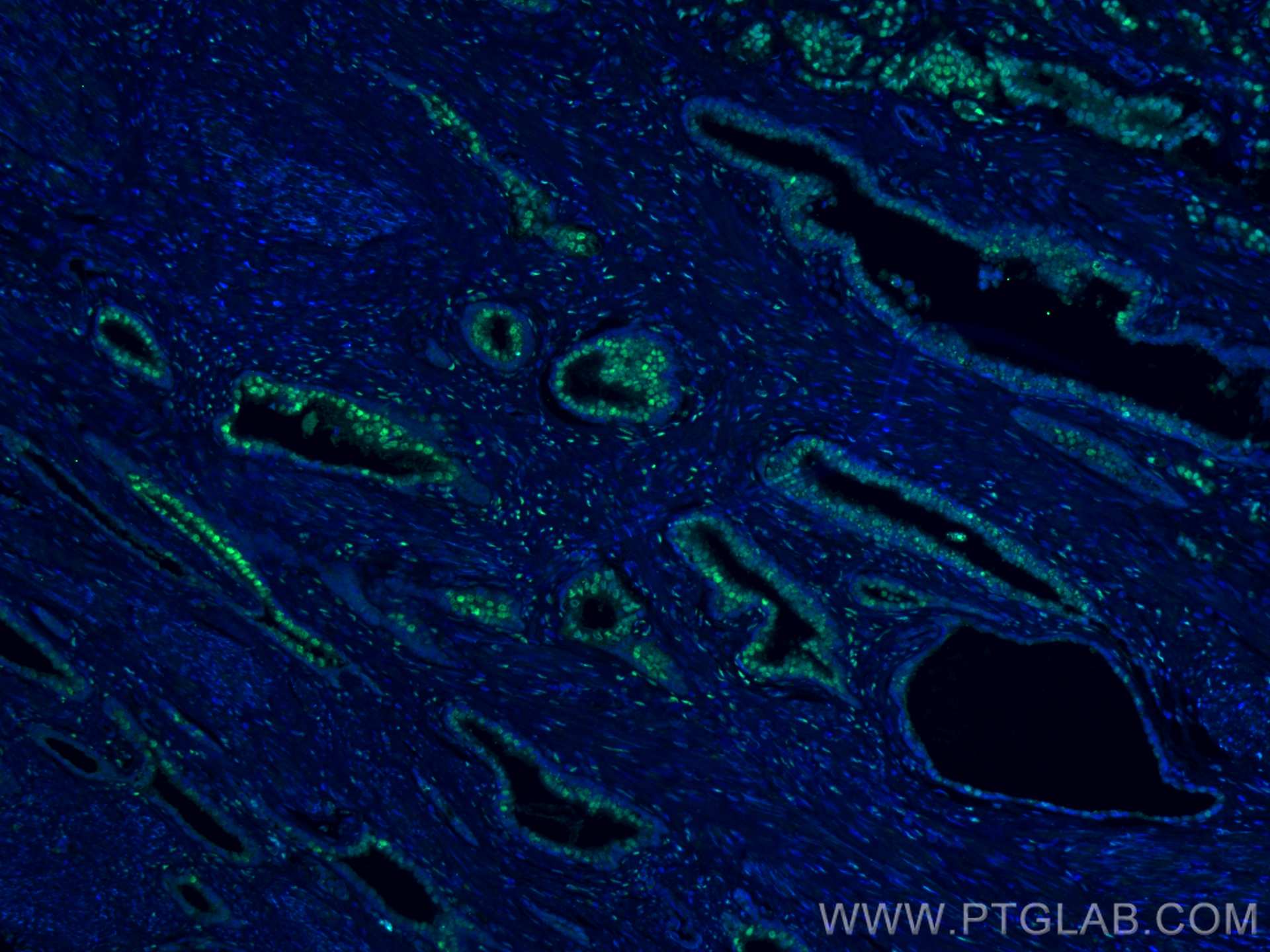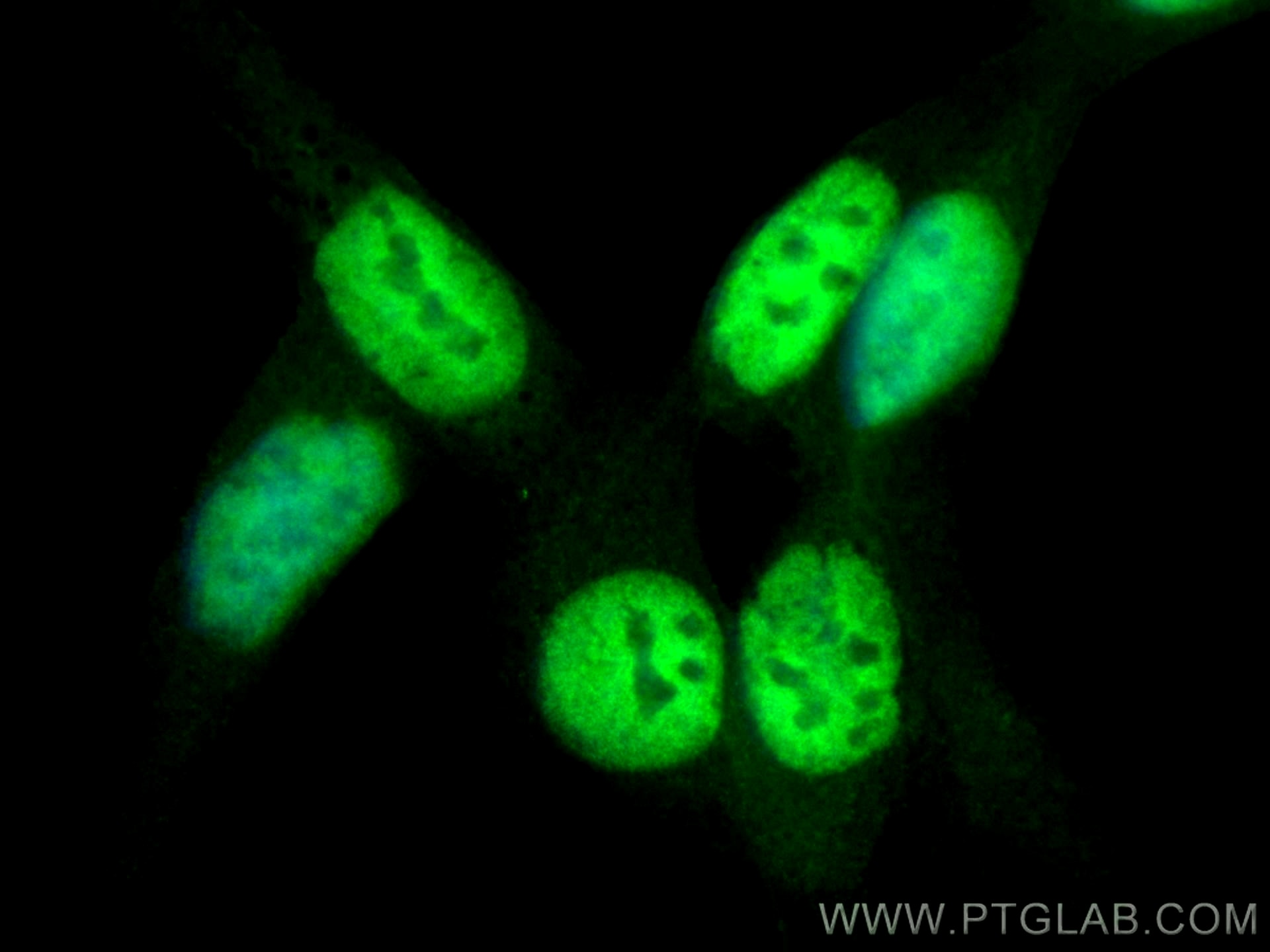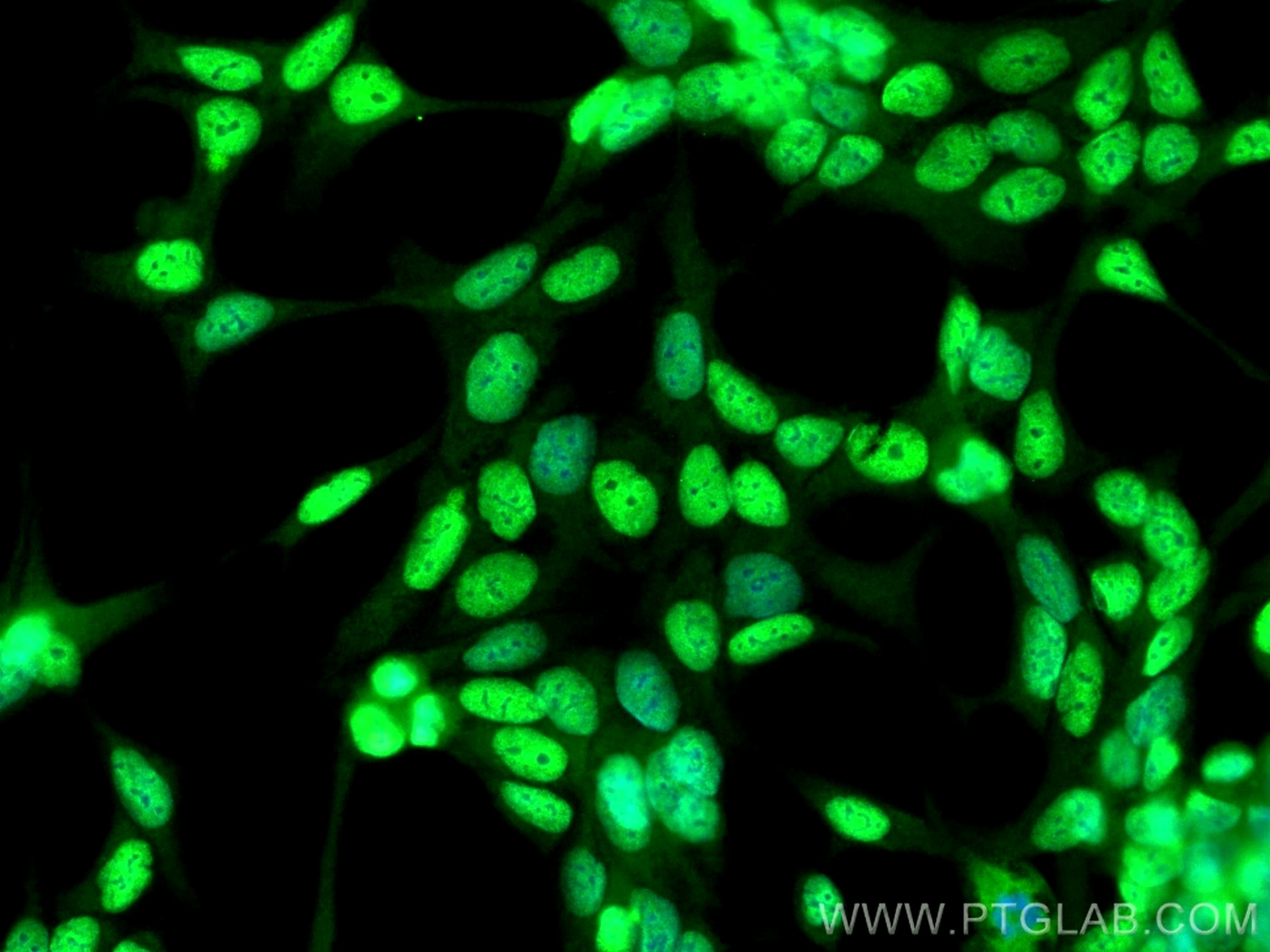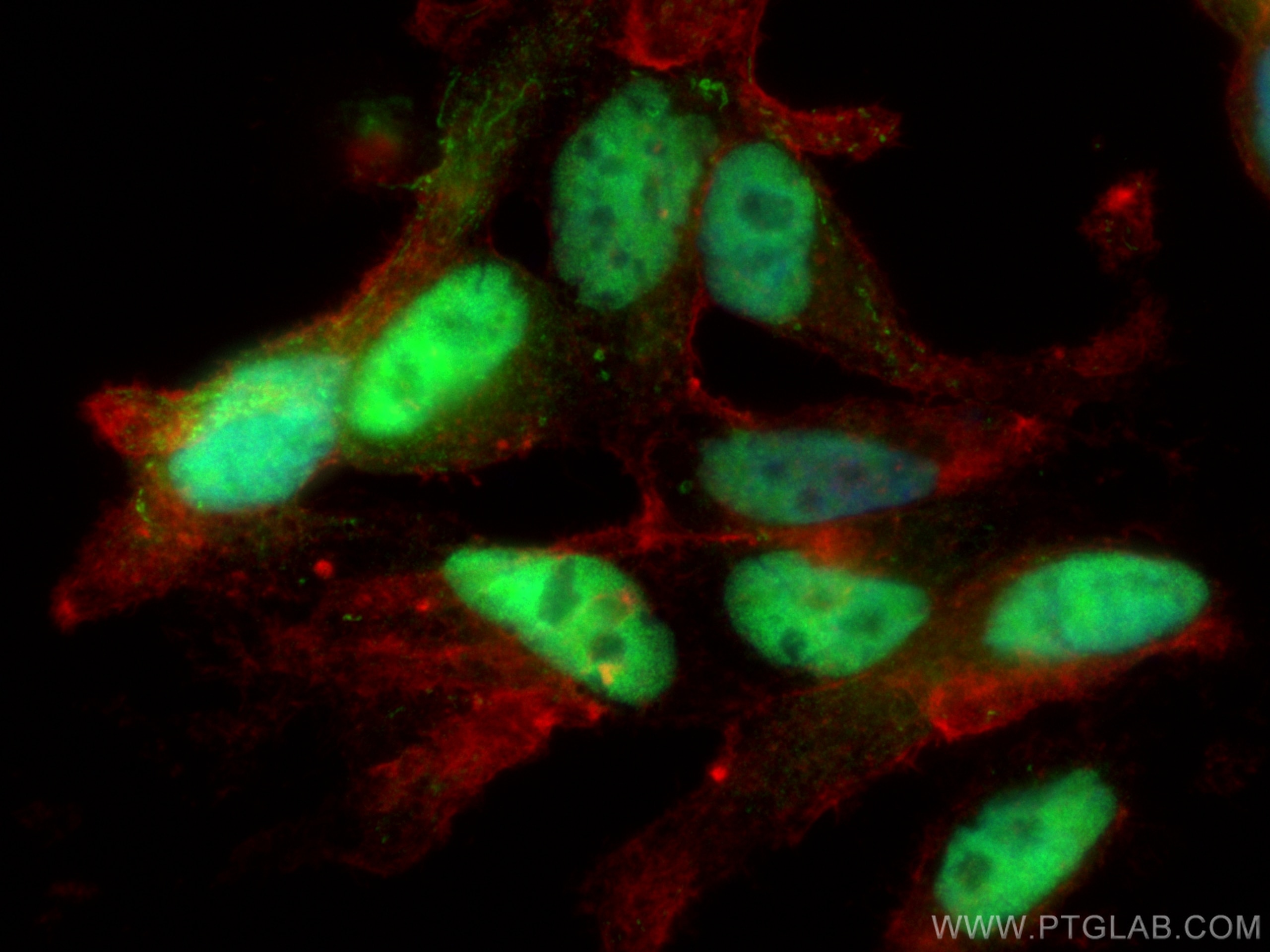- Phare
- Validé par KD/KO
Anticorps Polyclonal de lapin anti-androgen receptor
androgen receptor Polyclonal Antibody for WB, IHC, IF/ICC, IF-P, ELISA
Hôte / Isotype
Lapin / IgG
Réactivité testée
Humain, rat, souris et plus (2)
Applications
WB, IHC, IF/ICC, IF-P, IP, CoIP, ChIP, ELISA
Conjugaison
Non conjugué
N° de cat : 22089-1-AP
Synonymes
Galerie de données de validation
Applications testées
| Résultats positifs en WB | cellules LNCaP, cellules HepG2, cellules MCF-7, cellules NIH/3T3, tissu cardiaque de rat, tissu cardiaque de souris |
| Résultats positifs en IHC | tissu de cancer de la prostate humain, il est suggéré de démasquer l'antigène avec un tampon de TE buffer pH 9.0; (*) À défaut, 'le démasquage de l'antigène peut être 'effectué avec un tampon citrate pH 6,0. |
| Résultats positifs en IF-P | tissu de cancer de la prostate humain |
| Résultats positifs en IF/ICC | cellules LNCaP, |
Dilution recommandée
| Application | Dilution |
|---|---|
| Western Blot (WB) | WB : 1:5000-1:50000 |
| Immunohistochimie (IHC) | IHC : 1:200-1:800 |
| Immunofluorescence (IF)-P | IF-P : 1:50-1:500 |
| Immunofluorescence (IF)/ICC | IF/ICC : 1:200-1:800 |
| It is recommended that this reagent should be titrated in each testing system to obtain optimal results. | |
| Sample-dependent, check data in validation data gallery | |
Applications publiées
| KD/KO | See 2 publications below |
| WB | See 52 publications below |
| IHC | See 16 publications below |
| IF | See 16 publications below |
| IP | See 1 publications below |
| CoIP | See 1 publications below |
| ChIP | See 2 publications below |
Informations sur le produit
22089-1-AP cible androgen receptor dans les applications de WB, IHC, IF/ICC, IF-P, IP, CoIP, ChIP, ELISA et montre une réactivité avec des échantillons Humain, rat, souris
| Réactivité | Humain, rat, souris |
| Réactivité citée | rat, Humain, Lapin, porc, souris |
| Hôte / Isotype | Lapin / IgG |
| Clonalité | Polyclonal |
| Type | Anticorps |
| Immunogène | androgen receptor Protéine recombinante Ag17291 |
| Nom complet | androgen receptor |
| Masse moléculaire calculée | 914 aa, 99 kDa |
| Poids moléculaire observé | 75-80 kDa, 110-120 kDa |
| Numéro d’acquisition GenBank | BC132975 |
| Symbole du gène | AR |
| Identification du gène (NCBI) | 367 |
| Conjugaison | Non conjugué |
| Forme | Liquide |
| Méthode de purification | Purification par affinité contre l'antigène |
| Tampon de stockage | PBS with 0.02% sodium azide and 50% glycerol |
| Conditions de stockage | Stocker à -20°C. Stable pendant un an après l'expédition. L'aliquotage n'est pas nécessaire pour le stockage à -20oC Les 20ul contiennent 0,1% de BSA. |
Informations générales
1. What is the molecular weight of AR? Are there any isoforms of AR?
The molecular weight of full-length androgen receptor (AR-B) is 110 kDa. An additional variant, AR-A, has an 87 kDa size and lacks the N-terminal 187 amino acids of AR-A (PMID: 8108393). Recently, more splice variants of AR have been discovered, raising protein products of around 80 kDa length (PMID: 19244107), as well as an AR45 variant of 45 kDa size (PMID: 15634333). AR splice variants differ in their cell line-specific expression (PMID: 24570075).
2. What is the subcellular localization of AR?
AR can be present in either or both of the cytoplasm and nucleus. In androgen-deprived cells, AR is found predominantly in the cytoplasm, while stimulation by androgens causes enrichment of androgen-bound AR in the nucleus. AR shuttles between the cytoplasm and nucleus and its phosphorylation state has an impact on the subcellular localization (PMID: 16282370).
3. Is AR post-translationally modified?
Post-translational modifications of the AR include phosphorylation, acetylation, methylation, SUMOylation, and ubiquitination (PMID: 21820033). These modifications have an impact on receptor stability, activity, and can change the observed molecular weight of the AR.
4. How to study AR signaling in cell culture?
It is important to control levels of cell stimulation while also looking at AR signaling. Fetal bovine serum (FBS) that is typically used in cell culture contains low levels of testosterone that are enough to stimulate the growth of prostate cells (PMID: 19676093), including the LNCaP cell line that is a commonly used human prostatic carcinoma cell model (PMID: 6831420). One possibility for complete testosterone deprivation is to use charcoal stripped FBS that removes lipophilic agents, including androgens. It is also not recommended to use phenol red in your medium because it is a weak estrogen (PMID: 3458212). Cell stimulation is often conducted by dihydrotestosterone (DHT).
5. What is the role of AR in prostate cancer?
AR plays a key role in the development and physiology of the prostate gland, and also cancer progression (PMID: 15082523). Mutations in AR altering ligands have been observed. The progression of the prostate cancer depends on AR activity and therefore blocking AR activity or lowering androgen levels is a key step related to androgen deprivation therapy (ADT).
Protocole
| Product Specific Protocols | |
|---|---|
| WB protocol for androgen receptor antibody 22089-1-AP | Download protocol |
| IHC protocol for androgen receptor antibody 22089-1-AP | Download protocol |
| IF protocol for androgen receptor antibody 22089-1-AP | Download protocol |
| Standard Protocols | |
|---|---|
| Click here to view our Standard Protocols |
Publications
| Species | Application | Title |
|---|---|---|
Nucleic Acids Res SMAD3 promotes expression and activity of the androgen receptor in prostate cancer | ||
Research (Wash D C) The FTO Mediated N6-Methyladenosine Modification of DDIT4 Regulation with Tumorigenesis and Metastasis in Prostate Cancer | ||
Oncogene Identification of low-frequency variants of UGT1A3 associated with bladder cancer risk by next-generation sequencing. | ||
Biomed Pharmacother Therapeutic targeting of histone lysine demethylase KDM4B blocks the growth of castration-resistant prostate cancer | ||
J Transl Med CAPN2 promotes apalutamide resistance in metastatic hormone-sensitive prostate cancer by activating protective autophagy | ||
J Environ Sci (China) The effects of 17β-trenbolone and bisphenol A on sexual behavior and social dominance via the hypothalamic-pituitary-gonadal axis in male mice |
Avis
The reviews below have been submitted by verified Proteintech customers who received an incentive for providing their feedback.
FH Kis (Verified Customer) (02-21-2025) | This antibody did not yield satisfactory results in our cell line for Western blot (WB) analysis.
|
FH Antonio (Verified Customer) (03-27-2023) | This antibody worked better than expected. Better than several Same antibody from different company
|
FH Emma (Verified Customer) (11-29-2021) | We couldn't get this antibody to work by IF on FFPE tissue.
|
FH Saswati (Verified Customer) (08-20-2019) | This antibody worked in a cell line with a lower expression of AR, when another antibody from another vendor did not work. I am very pleased with its earlier lot.Also, since this is a polyclonal antibody, many bands light up, but in my opinion these are legitimate bands.Also hoping that the quality control keeps good eye from one lot to another., I have yet to use the particular lot# I put in this note.Thanks
|
